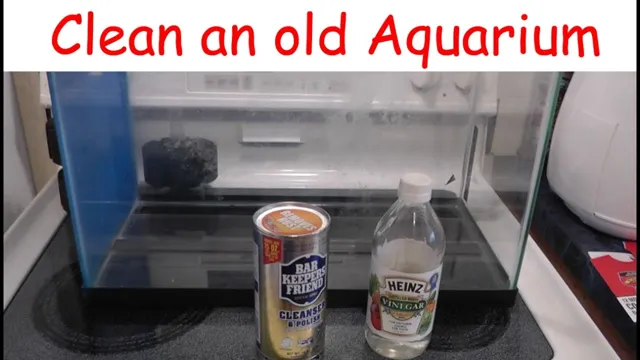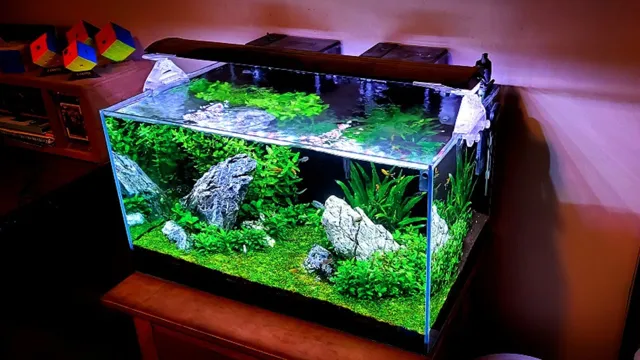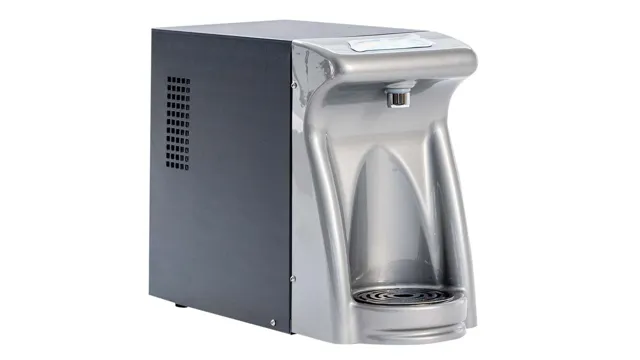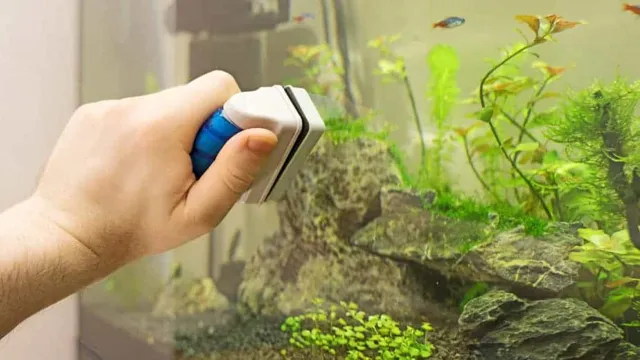If you’re a proud aquarium owner, you know that keeping your fish’s home clean and healthy is important. Regular maintenance is key, and that includes keeping your aquarium free of calcium buildup. Calcium buildup can be unsightly and harmful to your fish, causing pH imbalances and other problems.
But don’t worry, cleaning your aquarium of calcium isn’t hard, and it doesn’t have to be time-consuming. In this blog, we’ll explore some effective ways to clean calcium buildup off your aquarium, leaving it looking and functioning better than ever before. So grab your cleaning supplies, put on some music, and let’s get started!
Understanding Calcium Buildup
If you’re an aquarium owner, then you’re probably familiar with calcium buildup. It’s when mineral deposits accumulate on the surfaces of your aquarium, and it can be frustrating to deal with. But don’t worry, there are ways to clean calcification off aquarium surfaces.
One way is to use a mixture of vinegar and water. Simply soak a cloth in the solution and wipe down any affected areas. Another option is to use a specialized calcium remover product.
These products are specifically designed to break down calcium and make it easier to remove. It’s important to address calcium buildup as soon as possible, as it can harm your aquarium’s inhabitants and also make your tank look unsightly. By taking proactive steps to prevent and remove calcium buildup, you can help ensure a healthy and beautiful aquarium for years to come.
What Causes Calcium Buildup in Aquariums
Calcium buildup is a common problem in aquariums, causing cloudy water, clogged filters, and damage to equipment. Understanding the causes of calcium buildup is important to prevent the issue from occurring in the first place. One primary culprit behind calcium buildup is hard water, which contains high levels of calcium and magnesium.
As the water evaporates, these minerals are left behind and gradually accumulate on surfaces in the aquarium, leading to buildup over time. Another common cause of calcium buildup is overfeeding, which can result in excess organic matter that contributes to the growth of calcium deposits. To keep your aquarium free of calcium buildup, it’s important to regularly test the water and adjust accordingly, limit overfeeding, and maintain proper filtration.
By taking steps to prevent calcium buildup, you can ensure a healthy and thriving aquatic environment for your fish and other aquatic life.

The Dangers of Calcium Buildup in Aquariums
Calcium buildup is a common problem that many aquarium hobbyists face. When the water in the aquarium contains high levels of calcium, it can build up on surfaces over time and cause a host of issues. This buildup can occur on the walls of the aquarium, the substrate, and even on the aquarium decorations.
The primary concern with calcium buildup is that it can make it harder to clean your aquarium and maintain a healthy environment for fish and other aquatic creatures. Additionally, high levels of calcium can lead to algal growth and can even cause damage to the aquarium’s filtration system. To prevent calcium buildup, it’s important to monitor the water’s calcium levels and perform regular cleanings.
Using specialized aquarium cleaning tools and brushes can make it easier to remove the buildup from surfaces without damaging them. By staying on top of calcium buildup, you can keep your aquarium healthy and enjoyable for both you and your aquatic pets.
Tools and Materials Needed to Clean Calcium Buildup off Your Aquarium
Cleaning calcium buildup off your aquarium requires a few essential tools and materials. The first and most important item you will need is a scraper or scouring pad. This tool will help to remove any stubborn calcification that has attached itself to the aquarium walls.
Next, you will need a cleaning solution that is specifically designed for aquarium use. Avoid using household cleaners as they can harm your fish and plants. A good aquarium cleaning solution will break down the calcium buildup, making it easier to remove.
A bucket, gloves, and a siphon vacuum will also come in handy for removing dirty water, gravel, and debris from the aquarium. Finally, a good quality fishnet will help to remove any loose particles floating in the water. With these tools and materials, you can clean the calcium buildup off your aquarium and keep your fish healthy and happy.
Safety Precautions Before You Begin Cleaning
When it comes to cleaning calcium buildup off your aquarium, safety should be your top priority. Before you begin, make sure you have the necessary tools and materials to do the job properly. You’ll need rubber gloves to protect your hands from the cleaning solution, a scraper blade to remove the buildup, and a soft cloth to wipe away any residue.
It’s also important to wear eye protection to prevent any accidental splashes from getting in your eyes. Once you have everything you need, it’s time to get to work and restore your aquarium to its former glory. Just remember to take it slow and be careful not to damage the surface of the glass or any decorations inside.
By following these safety precautions, you can ensure a successful and safe cleaning experience for you and your aquatic pets.
Tools and Materials Overview
When it comes to cleaning calcium buildup off your aquarium, having the right tools and materials is crucial. First and foremost, you’ll need a good quality scraper or scraper pad to physically remove the buildup from the glass or acrylic surfaces. Additionally, a soft-bristled brush can be helpful for reaching nooks and crannies. (See Also: How to Get Rid of Diatoms in Saltwater Aquarium with Effective Techniques)
In terms of cleaning solutions, vinegar is a popular choice due to its ability to dissolve calcium deposits. However, be sure to dilute it with water to avoid damaging your aquarium’s delicate ecosystem. A siphon or gravel cleaner may also come in handy for removing any calcium particles that have collected on the bottom substrate.
Overall, having a variety of tools and materials at your disposal will make the cleaning process much easier and more effective.
Step-by-Step Guide for Removing Calcium Buildup from Your Aquarium
Cleaning calcium buildup from an aquarium can be a daunting task, but it’s essential for maintaining a healthy environment for your fish. The first step is to remove any fish or plants from the tank to prevent them from getting harmed during the cleaning process. Once the tank is empty, use a scraper or a razor blade to gently remove the calcification from the glass walls and the decorations in your tank.
If the buildup is stubborn, you can use a solution of equal parts water and vinegar to soften it before scraping. Be careful not to use any harsh chemicals or abrasive materials as they can damage the glass. After you’ve cleaned the aquarium, perform a water change and rinse the tank thoroughly, making sure to remove any debris and vinegar residue.
Calcium buildup is a common issue in aquariums, so it’s important to maintain a regular cleaning schedule to ensure your aquatic friends have a safe and healthy home.
Preparation Before Cleaning
Removing calcium buildup from your aquarium can be a daunting task, especially if you don’t know where to start. Before you jump in and start scrubbing away at the buildup, it’s essential to make some preparations first. Begin by turning off all the equipment in your aquarium, including the filter and any lights.
This step will prevent any water disturbances that could irritate your fish or cause debris from the buildup to disperse throughout the aquarium. Next, remove any decorations, artificial plants, or ornaments from your aquarium. These items can harbor calcium deposits, and cleaning them separately will be more comfortable and allow for a more thorough cleaning.
Ensure that you have all the necessary cleaning supplies, including a glass scraper or small brush, vinegar or CLR, gloves, and a clean cloth. Once you have everything, you can move on to the cleaning process and begin removing unsightly calcium buildup.
Removing the Fish from the Tank
Removing calcium buildup from your aquarium can be daunting, but with the right tools and approach, it can be a breeze. The first step is to remove all the fish from the tank and place them in a temporary holding container. It is important to do this to prevent them from being exposed to any chemicals or stress during the cleaning process.
Once the fish are safely removed, the next step is to drain the tank of all the water and remove any decorations or plants. Any buildup of calcium can be scrubbed off using a brush or scraper, but if it’s particularly stubborn, you may need to use a specialized aquarium cleaner or vinegar solution. After you’ve cleaned the tank thoroughly, it’s time to rinse it out with fresh water to ensure that there are no remaining chemicals or particles that could harm your fish.
Be sure to clean any decorations or plants that you removed from the tank before putting them back in. Before adding your fish back to the tank, it’s important to let it sit for at least 24 hours to allow the water to fully cycle and regain its balance. Once this is done, you can safely add your fish back to their home.
In summary, removal of calcium buildup from your aquarium requires patience and a systematic approach. Removing the fish before cleaning, scrubbing off the buildup, rinsing and drying the tank, cleaning decorations, letting the tank rest, and returning the fish to the area is the process. With a little effort and care, your aquarium will be sparkling and ready to accommodate your fish.
Cleaning Solution Preparation
If you’re dealing with stubborn calcium buildup in your aquarium, you need a reliable cleaning solution to get rid of it. But before you start, make sure you have all the materials you need. First, drain the water from the aquarium and remove any items inside.
Then, prepare your cleaning solution. You can make a solution by mixing hot water with vinegar or citric acid and pour it once it is cool. Use a 1:1 ratio of water and vinegar or citric acid to effectively dissolve the calcium buildup.
While scrubbing the walls and floor of the tank, be mindful of the pressure you’re applying. Too much pressure can scratch the surface and leave your aquarium vulnerable to algae growth. Rinse the aquarium thoroughly and check for any remaining buildup.
Repeat the process if necessary. With this step-by-step guide and the right cleaning solution, you can get rid of calcium buildup and keep your aquarium looking new once again.
Cleaning the Glass
Keeping your aquarium clean is crucial for the health of your fish and the overall appearance of your tank. Calcium buildup is a common problem for aquarium owners, but with the right steps, it can be easily removed. The first step is to prepare a cleaning solution, which usually involves mixing a 1:1 ratio of water and vinegar. (See Also: How to Get Algae Off of Aquarium Stuff: Tips and Tricks for a Clean Tank)
Next, use a scraper or soft-bristled brush to gently remove the buildup from the glass. Be sure to avoid any abrasive tools which can scratch or damage the glass. Once you have removed the majority of the buildup, use a clean cloth to wipe away any remaining residue.
Repeat the process as needed until your glass is clear and free of calcium buildup. By regularly maintaining your aquarium glass, you can ensure a healthy and beautiful home for your fish.
Cleaning Decorations and Equipment
Do you notice white, crusty deposits appearing on the walls of your aquarium or on your decorations and equipment? This is most likely caused by calcium buildup, which can be harmful to your fish if not properly addressed. To remove it, follow these simple steps. First, take out all the items in your aquarium that have calcium deposits.
You can soak them in a solution of vinegar and water (equal parts) for about 30 minutes. Then, scrub them with a soft brush or sponge and rinse them thoroughly with water. For the aquarium walls, you can use a scraper or a razor blade to gently scrape off the buildup.
Be careful not to scratch the glass. Once you’re done, do a water change and use a water conditioner to make sure that the water is safe for your fish. Remember to regularly clean your aquarium to prevent the buildup of calcium and other harmful substances.
With these steps, your aquarium will look as good as new and your fish will thank you.
Rinsing and Refilling the Tank
If you’re an aquarium owner, you know the importance of maintaining a clean and healthy tank. One of the major issues you may face is the buildup of calcium deposits on the aquarium walls. Not only does it affect the aesthetic appeal of your tank, but it can also harm the fish and plants living in it.
To remove calcium buildup, you’ll need to rinse and refill the tank. Start by turning off and unplugging all electrical equipment. Remove the aquarium decorations, plants, and rocks and use a scraper to remove the calcium buildup.
Once you’ve completed that, rinse the tank thoroughly with warm water and refill it with treated water. It’s essential to add beneficial bacteria to the water to ensure that the water remains clean and healthy for your aquatic pets. Don’t forget to plug all the electrical equipment back in and add the decorations, plants, and rocks back into the tank.
By following these steps, you can easily remove calcium buildup from your aquarium and ensure that your fish and plants thrive in a clean and healthy environment.
Prevention Tips to Avoid Calcium Buildup in Your Aquarium
As an aquarium owner, one of the biggest challenges is dealing with calcium buildup, or calcification, on the glass or other surfaces of your tank. Not only is it unsightly, but it can also be harmful to your fish and other aquatic creatures if left unaddressed. To keep your aquarium clean and healthy, there are a few prevention tips to keep in mind.
Firstly, try to avoid overfeeding your fish, as excess food can lead to increased calcium levels in the water. Using a filtration system can also help to minimize calcification. Wiping down the inside of the tank regularly can prevent buildup from sticking and hardening over time.
Another effective method is to use a scraper or razor blade to remove stubborn spots. Be sure to use caution when doing this, as you don’t want to scratch the glass. Overall, with regular maintenance and a few simple prevention strategies, it is possible to keep calcium buildup under control and maintain a beautiful, healthy aquarium.
Regular Tank Maintenance and Cleaning Habits
Keeping a regular maintenance and cleaning schedule is an essential aspect of aquarium ownership. Not only does it help to maintain the visual aspect of your aquarium, but it also prevents calcium buildup. Calcium buildup can cause issues such as cloudy water and harm to fish and plant life.
Prevention tips include regular partial water changes, routine cleaning of aquarium decor, and testing water parameters regularly. Additionally, ensuring proper filtration and not overfeeding your fish can also prevent calcium buildup. By incorporating these preventative measures, you can keep your aquarium looking pristine and your aquatic life healthy and thriving.
So, don’t forget to schedule in regular cleaning and maintenance to avoid unwanted calcium buildup in your aquarium. (See Also: How to Build an External Aquarium Filter: A Step-by-Step Guide for Crystal Clear Water)
Using the Right Water Source for Your Aquarium
If you own an aquarium, you know how important it is to use the right water source. Using tap water might seem like an easy solution, but it can lead to a buildup of calcium in your aquarium. This buildup can not only be unsightly but can also harm your aquatic pets.
That’s why it’s essential to take some preventative measures to avoid this problem. Firstly, test the water’s pH level before using it in your tank. You can buy pH test kits from pet stores or online.
Secondly, avoid using water from a water softener as it contains high levels of sodium that can harm your fish. Lastly, consider using reverse osmosis (RO) water or distilled water as it has low levels of calcium and other minerals. Regularly checking and maintaining your aquarium’s water source can prolong the life of your aquatic pets and provide a more natural environment for them to thrive in.
Don’t risk it; take preventative measures now to avoid any potential calcium buildup in your aquarium.
Proper Feeding Practices for Your Fish
Proper feeding practices are crucial when it comes to maintaining a healthy aquarium. But did you know that overfeeding or using improper foods can lead to calcium buildup in your tank? This buildup can cause serious problems for your fish, including reduced oxygen levels and pH imbalance. To prevent calcium buildup, make sure to only feed your fish the recommended amount of food, and choose foods that are specifically formulated for your fish’s species.
Additionally, adding a calcium remover to your filtration system can help to break down any excess buildup. By following these prevention tips, you can ensure that your fish stay healthy and happy in their aquarium.
Conclusion
In conclusion, cleaning calcification off your aquarium may seem like a daunting task, but with a little elbow grease and patience, it’s entirely achievable. Just remember to use a gentle yet effective cleaning solution, avoid harsh chemicals, and do it all in the name of providing a healthy and happy home for your aquatic companions. Because let’s face it, a clean tank is a happy tank, and that’s something we can all appreciate – even if we can’t swim in it ourselves!”
FAQs
What causes calcification to form in aquariums?
Calcification in aquariums is caused by the buildup of minerals and organic matter in the water, which can form hard deposits on various surfaces.
How can I tell if my aquarium has calcification buildup?
Signs of calcification buildup in an aquarium include cloudy water, white or grayish spots on surfaces, and reduced water flow in filters and pumps.
Can calcification be harmful to fish and aquatic plants?
Yes, excessive calcification in an aquarium can disrupt the balance of the ecosystem and harm fish and aquatic plants. It can also lead to the growth of harmful bacteria and algae.
What tools or products can I use to remove calcification from my aquarium?
There are several commercially available products and tools that can be used to remove calcification from aquariums, such as specialized cleaning solutions, scrubbing pads, and vacuum attachments.
Are there any natural remedies for cleaning calcification from aquariums?
Yes, some people recommend using vinegar or lemon juice to remove calcification from aquariums, although these methods should be used with caution and diluted with water to avoid harming fish and plants.
How often should I clean my aquarium to prevent calcification buildup?
It is recommended to clean your aquarium regularly, such as changing the water and cleaning the surfaces, filters, and pumps once every week to prevent calcification buildup.
Is it possible to prevent calcification from forming in my aquarium in the first place?
Yes, proper maintenance and care of your aquarium can prevent the buildup of calcification. This includes regular cleaning, maintaining proper water chemistry and filtration, and avoiding overfeeding or overcrowding of fish.







